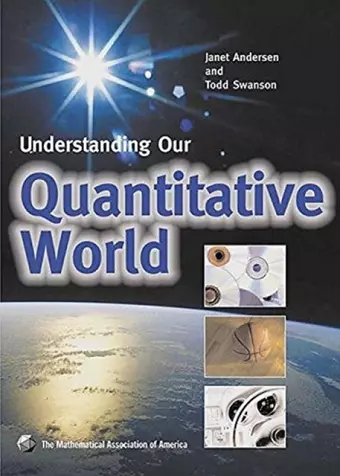Understanding Our Quantitative World
Janet Andersen author Todd Swanson author
Format:Hardback
Publisher:Mathematical Association of America
Published:1st Jan '05
Currently unavailable, our supplier has not provided us a restock date

This book is intended for a general education mathematics course. The authors focus on the topics that they believe students will likely encounter after college. These topics fall into the two main themes of functions and statistics. After the concept of a function is introduced and various representations are explored, specific types of functions (linear, exponential, logarithmic, periodic, power, and multi-variable) are investigated. These functions are explored symbolically, graphically, and numerically and are used to describe real world phenomena. On the theme of statistics, the authors focus on different types of statistical graphs and simple descriptive statistics. Linear regression, as well as exponential and power regression, is also introduced. Simple types of probability problems as well as the idea of sampling and confidence intervals are the last topics covered in the text. The book is written in a conversational tone. Each section begins by setting the mathematics within a context and ends with an application. The questions at the end of each section are called ""Reading Questions"" because students are expected to be able to answer most of these after carefully reading the text. ""Activities and Class Exercises"" are also found at the end of each section. These activities are taken from public sources such as newspapers, magazines, and the Internet. Doing these activities demonstrates that mathematics can be used as a tool in interpreting quantitative information encountered in everyday life. The text assumes that students will have access to some type of technology such as a graphing calculator.
This text is part of the Mathematical Association of America's Classroom Resource materials series, which provides students with supplementary classroom materials. While the majority of the text's exposition includes many basic yet appropriate examples of the topic at hand, the authors explain in the preface that they expect the majority of course class time to be spent working with students on the more applied ""Activities and Class Exercises"" in a group setting. Each chapter includes example activities that incorporate public source data and ask students to think about relevant topics. Examples of these applied activities include analysis of credit card debt, tuition rates, textbook prices, car loans, and the destruction of the ozone layer. These topics and the mathematics that students would use to analyze them address the question, ""What mathematical skills and concepts are useful for informed citizens?"" This is the query upon which the authors base their text. The average student would find this book easy to read. There are many examples in every section, and tables and figures are clear and readily interpreted. Each section of reading includes one application problem and a number of reading questions. While many of these reading questions are quantitative in nature, the majority of the numerically based problems require some form of interpretation on the student's part. Generally, students should be able to answer the reading questions if they read the text, and these problems will allow students to delve deeper into the ""Class Exercises"" that are the richest aspect of the book. Three main topics addressed in the text are the application and interpretation of graphs; simple functions; and statistical information. the chapters are arranged such that these three main topics are scattered throughout the book. However, an instructor could easily choose the order in which to study the different topics. Chapter 6 focuses on multi-variable functions and contour diagrams, topics that students often find confusing, but Andersen and Swanson provide concrete examples that are well-written and easy to understand. At several points in the text, the authors use technology to help solve problems or display data. Instructions for using the TI-83 calculator are provided in an appendix and short supplementary directions can be found within the text. I recommend this text for college algebra instructors who would like to see their students use their mathematical skills to analyze and interpret real-world problems. The variety of data and applications will also inspire many curious students to think mathematically beyond the classroom."" - Hilary Fletcher, Mathematics and Computer Education
ISBN: 9780883857380
Dimensions: unknown
Weight: 715g
320 pages